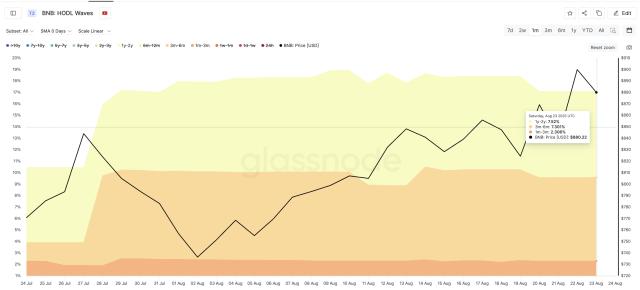The Power Behind Billions in US Debt: Stablecoins Continuously Expanding.
Author:Dingdang
Original:Odaily Planet Daily
Recently, the latest data disclosed by Tether shows that its US Treasury bond holdings have exceeded $120 billion, a figure that not only surpasses the holdings of sovereign countries like the UAE and Germany but also places this stablecoin issuer as the 18th largest US debt holder globally.
For those familiar with the crypto market, this number is astonishing; in traditional finance, it looks more like a "structural financial tectonic movement". Some argue that stablecoin issuers like Circle and Tether are consuming more US Treasury bonds than most countries, which could potentially reshape the US economy.
In supporters' eyes, this is a new extension of dollar hegemony: through on-chain liquidity and global payment networks, stablecoins provide an unprecedented lever for the US dollar to maintain its dominant position in international trade and digital assets. However, critics warn that even if stablecoins occupy a small part of the entire market, they could lead to banking financial instability, as stablecoins might draw funds away from bank deposits, and since deposits are necessary liquidity for loans, stablecoins could likely threaten the credit system.
Stablecoin Market Prosperity and Oligopoly

More interestingly, under this highly concentrated landscape, the market's innovative vitality has not been suppressed. Since 2024, the total number of stablecoins has increased to 282, with new categories constantly emerging from on-chain payments to cross-border settlements.

In terms of market value curves, USDT remains stable with slight growth, USDC has shown a slowdown in growth since May 2025, while the decentralized stablecoin USDe recorded over 75% month-on-month growth in July, becoming a "dark horse" disrupting the landscape.

USDT and USDC: Two Routes, Two Logics
Although USDT and USDC both promise 1:1 USD pegging, they have chosen entirely different directions in development paths and brand positioning.
Tether (USDT): A Market-Driven Controversial Pioneer
USDT is issued by Tether Limited, registered in Hong Kong and headquartered in Switzerland, dominating the stablecoin field with a market-driven approach. With extensive trading pairs and massive circulation, USDT has become the most commonly used stablecoin in the crypto market, even maneuvering skillfully in gray areas. However, its reserve transparency has long been criticized. In October 2021, Tether was fined $41 million by US regulatory agencies for reserve fund issues. Despite regularly publishing reserve reports, the insufficient audit frequency and details still cast doubt on market trust.
Circle (USDC): A Compliant and Stable Choice
In contrast, USDC follows a compliance-oriented route. Issued by the Centre Consortium founded jointly by Circle and Coinbase, Circle is a fintech company regulated by US financial regulators (FinCEN), publishing monthly reserve reports audited by third-party accounting firms like Grant Thornton, proving its sufficient USD reserves. Although USDC's market scale is smaller than USDT, it is favored in DeFi and institutional trading due to its high transparency and compliance.
This is not just a difference between two products, but a strategic bet on the future: one betting on market efficiency and liquidity, the other on institutional trust and compliance moats.
Stablecoin "Money-Absorbing" Logic: Zero-Cost Deposits and Massive Profits
The business model of stablecoin issuers is the clearest and most direct in the crypto industry, with its core being zero-cost deposit collection and stable interest spreads. When a user exchanges $100 for 100 stablecoins, these $100 become the issuer's reserves. Since stablecoins do not pay interest to users, the issuer essentially obtains a zero-cost deposit. They then invest these funds in high-liquidity, low-risk assets like US Treasury bonds and repurchase agreements, earning stable interest returns.
Under a billion-scale fund pool, this model becomes a continuously operating profit machine: stable returns, controllable risks, almost the most predictable business model in the crypto industry.
For example, in Tether's asset portfolio, cash equivalents such as U.S. Treasury bonds account for over 80%, Bitcoin accounts for 5%, and the remainder is distributed among corporate bonds, precious metals, and secured loans. By the second quarter of 2025, Tether's U.S. Treasury holdings reached $127 billion (direct holdings of $105.5 billion, indirect holdings of $21.3 billion), surpassing South Korea's $124.2 billion and ranking 18th globally.
The significance of this portfolio structure lies not only in the profitability of the stablecoin market but also in its position in the U.S. dollar liquidity cycle. Stablecoins provide global users with an instant access to U.S. dollars while channeling these funds back into the U.S. Treasury market, forming a "dollar-on-chain-U.S. Treasury" circulation channel. This channel enhances global demand for U.S. Treasuries but may also amplify liquidity fluctuations in extreme situations, as stablecoin redemption demands are more immediate and concentrated compared to traditional bank deposits.
Circle, on the other hand, adopts a more conservative asset allocation: 44% in U.S. Treasury bonds, 44% in Treasury repurchase agreements, and 15% in bank deposits. As of June 30, 2025, its Treasury and repurchase agreements totaled approximately $54 billion.(A -3% difference is a temporary variation for trading or settlement, which typically balances out in the short term and does not pose a significant threat to overall reserve stability) This configuration is closer to the risk management logic of traditional financial institutions and implies a relatively stable balance between short-term redemption and interest income.

Financial Performance: The Other Side of Profits
According to the second-quarter 2025 financial data, Tether's total assets reached $162.57 billion, total liabilities (token issuance) were $157.11 billion, with net assets of approximately $5.47 billion, maintaining stable shareholder capital. In the second quarter alone, Tether realized a net profit of $4.9 billion, with a cumulative profit of $5.7 billion in the first half of the year, of which $3.1 billion came from recurring profits and $2.6 billion from valuation increases in gold and Bitcoin holdings. This means a significant portion of its profitability depends on asset price fluctuations, and while the current market environment is favorable, valuation gains could quickly shrink during a market downturn.
Circle demonstrates more "bank-like" financial characteristics—as of June, total assets were $61.39 billion, total liabilities $61.33 billion, with assets slightly exceeding liabilities. According to tokenterminal.com data, protocol revenue over the past year reached $1.9 billion. Primarily from interest income on Treasury bonds and repurchase agreements, with almost no reliance on high-volatility assets. This model is highly attractive in the current high-interest-rate environment but may face income pressure if the U.S. enters a rate-cutting cycle.

On July 18, 2025, U.S. President Trump signed the GENIUS Act, defining new boundaries for the stablecoin industry, marking a turning point for stablecoins moving from marginal innovation to mainstream finance. This legislation is not only a response to industry expansion but also reflects the U.S. intent to incorporate stablecoins into its "digital dollar" strategic landscape.
For compliant issuers like Circle, the act means expanded market space; for Tether, global market advantages may face challenges due to pressures on reserve transparency and compliance standards. Regardless of the ultimate outcome, stablecoins are becoming an extension of U.S. dollar hegemony in the digital age, introducing new variables to the global financial system.
Disclaimer: As a blockchain information platform, the articles published on this site represent only the personal views of the authors and guests, and are unrelated to Web3Caff's stance. The information in the article is for reference only and does not constitute any investment advice or offer. Please comply with the relevant laws and regulations of your country or region.
Welcome to join the Web3Caff official community: X(Twitter) account丨Web3Caff Research X(Twitter) account丨WeChat reader group丨WeChat official account








